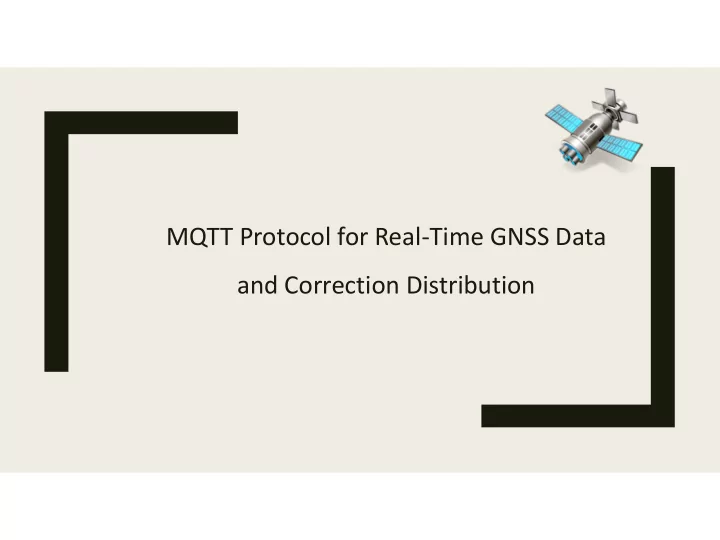

MQTT Protocol for Real ‐ Time GNSS Data and Correction Distribution
Precise Positioning
Precise P Precise Positioning sitioning ■ Real-Time Kinematic (RTK) positioning ■ Precise Point Positioning (PPP) ■ Requires additional correction! ■ Communication mediums – VHF/UHF radio – WAN/LAN/WLAN – 3G/4G cellular network ■ Communication Protocols – TCP/IP server – NTRIP
Precise P Precise Positioning sitioning ■ Networked Transfer of RTCM via Internet Protocol (Ntrip) – Radio Technical Commission for Maritime Services standard – Dissemination of GNSS observation and correction since 2004 – HTTP/1.1 standard – Support hundreds of reference stations and up to thousand users ■ Not suitable for future applications
MQTT MQTT ■ Message Queue Telemetry Transport (MQTT) protocol – publish-subscribe model – broker distribute messages based on the topic of a message – Suitable for low-bandwidth, low-power, limited hardware resources – Advance features: QoS, security supports, high availability – Used by Facebook Messenger, Amazon Web Services, OpenStack and Microsoft Azure.
Ntrip Ntrip vs MQTT s MQTT ■ Server performance – System loads (CPU, memory) under various operational scenarios ■ Positioning performances Ntrip MQTT Positioning • Str2str – • Mosquitto broker • Rtkrcv rtk NtripCaster and and clients positioining NtripClient • Paho MQTT • Python ‐ based python libraries Ntrip client
Ntrip Ntrip vs MQTT QTT Nectar S1 Nectar S1 GA Ntrip Caster Nectar S4 Nectar S4 NTRIP Caster NTRIP Cast er Nectar S3 S3 Data stream connection and management & Positioning Data stream manipulation and distribution - Ntrip Server Nectar S2 Nectar S2 - MQTT publisher Se Sever Conf r Config ig - 1 CPU @ 2.3GHz 1 CPU @ 2.3GHz - 4 GB 4 GB ram ram MQTT brok MQTT br oker er - 40 GB 40 GB HD HD disk disk
Syst System Load Com em Load Comparison arison ■ MQTT broker requires less resources than Ntrip with similar incoming data streams – NtripCaster: 4.7%11.76%, 36.68%, 89.67% for 50/200/500/1000 incoming data streams. – MQTT server load were 0.28%, 0.85%, 2.06%, 4.00% for the same scenarios. – no significant use of memory 100.00 90.00 Server CPU Usage (%) 80.00 70.00 60.00 50.00 NtripCaster 40.00 MQTT Broker 30.00 20.00 10.00 0.00 Number of Reference Station Data Connection
Syst System Load Com em Load Comparison arison ■ User connections have less stress on the server load. – For a commercial CORS network of 300 reference stations – NtripCaster load 19.77% to 29.33% for 50 and 500 user connections – MQTT broker load 2.07% to 8.69% for the same scenario Ntrip rip Caster an er and MQTT B TT Broker er Se Server lo er load ad - outgoing going 35 30 Server CPU Usage (%) 25 NtripCaster 20 15 MQTT Broker 10 5 0 (300,50) (300,100) (300,200) (300,300) (300,400) (300,500) Number of Data Connections
Positioning V sitioning Validation lidation ■ Positioning configuration – STR17 as rover via Ntrip – STR24 as base via Ntrip or MQTT – RTK positioning solution – Two rtkrcv module running simultaneously ■ Positioning via MQTT protocol – Python MQTT client subscript to STR24 data stream – Data streamed to local TCP server (localhost:10011) – RTKRCV connected to the TCP server to get data streamed from MQTT broker
Positioning V sitioning Validation lidation MQTT vs NTRIP
Differences between NTRIP/MQTT positioning solution ■ Insignificant RMS positioning variation between NTRIP/MQTT solution – 0.1mm in the horizontal and 0.4mm in vertical – due to network latency/packet losses. – 23 instances of latency difference, 15 of which MQTT > NTRIP
Conclusion and Future W Conclusion and F ture Works MQTT broker is more efficient than Ntrip Caster in handling large • load Less computing resources needed • Horizontal scalability (emqtt / HiveMQ, etc) • Advance features such as QoS, SSL/TSL, topic subscription • Different topic level publish and subscription • MQTT/GNSS/CORS/STR24/RTCMv3/GPS/1019 (GPS NAV) MQTT/GNSS/CORS/STR24/RTCMv3/GAL/1045 (GAL NAV) MQTT/GNSS/CORS/STR24/RTCMv3/GPS/1077 (GPS OBS) MQTT/GNSS/CORS/STR24/RTCMv3/GAL/1097 (GAL OBS) Subscript: MQTT/GNSS/CORS/STR24/RTCMv3/GPS/# (all topic under STR24 level)
Conclusion and F Conclusion and Future W ture Works Future testing and validation • Latency • Bandwidth optimization • Security • MQTT v5 features • Field vehicle testing •
Recommend
More recommend